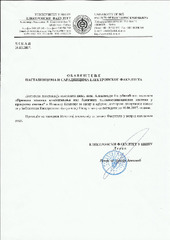Приказ основних података о дисертацији
Primena tehnika kombinovanja kod bežičnih telekomunikacionih sistema u prisustvu smetnje
| dc.contributor.advisor | Milić, Dejan | |
| dc.contributor.other | Perić, Zoran | |
| dc.contributor.other | Milović, Danijela | |
| dc.contributor.other | Đorđević, Goran T. | |
| dc.contributor.other | Petrović, Mile | |
| dc.creator | Golubović, Aleksandra D. | |
| dc.date.accessioned | 2018-02-26T12:40:21Z | |
| dc.date.available | 2018-02-26T12:40:21Z | |
| dc.date.available | 2020-07-03T16:02:43Z | |
| dc.date.issued | 2017-10-16 | |
| dc.identifier.uri | https://nardus.mpn.gov.rs/handle/123456789/9144 | |
| dc.identifier.uri | http://eteze.ni.ac.rs/application/showtheses?thesesId=5577 | |
| dc.identifier.uri | https://fedorani.ni.ac.rs/fedora/get/o:1440/bdef:Content/download | |
| dc.identifier.uri | http://vbs.rs/scripts/cobiss?command=DISPLAY&base=70052&RID=533943446 | |
| dc.description.abstract | Research results shown in this thesis consider selection combining space diversity systems. Weibull fading model is used to describe a desired signal and interference in a wireless telecommunication channel. In an interference-limited environment, like a cellular communication system, the level of cochannel interference is sufficiently high compared to noise so that it can be neglected. In that case, a selection combining receiver can employ different combining algorithms, that can be used to forward the chosen signal to the output of the receiver. After the theoretical basis, which is given at the beginning of the thesis, a detailed analysis of space diversity systems that use different selection algorithms is presented. The system performance is analyzed using one of the proposed criteria: maximal signal-tointerference ratio, maximal desired signal, maximal total signal, and minimal interference. For a system employing each of these algorithms, a detailed analysis of statistical characteristics of first and second order is given using the expressions derived in this thesis. The first focus is on deriving the expressions for probability density function of instantaneous signal-to-interference ratio at the output of selection combining receiver employing each of the previously mentioned algorithms. Based on the derived expressions, numerical results are presented for statistical characteristics of the first order, namely outage probability, average bit error probability, average signal-to-interference ratio and channel capacity. Additionally, for the statistical characteristics of the second order, which are level crossing rate and average fade duration, expressions for joint probability density function of instantaneous signal-tointerference ratio and its time derivative are derived. A new mathematical approach for obtaining analytical expression for probability density function of instantaneous signal-to-interference ratio at the output of selection combining receiver with two branches that uses maximal signal-to-noise ratio algorithm is presented. Considering that mobile terminals are relatively small, the distance between receiving antennas is not large enough to be neglected. Therefore, the correlation between the branches is included in the analysis of statistical characteristics of the first order. Due to easier mathematical manipulation, statistical characteristics of second order do not consider correlation between receiving branches. Numerical results obtained using the expressions derived in this thesis for different decision algorithms are presented graphically. The illustrations show the influence of fading severity, correlation between the desired signals, as well as the interfering ones and balanced and unbalanced inputs for each of mentioned algorithms on outage probability, average bit error probability, average signal-to-interference ratio and channel capacity. The results for second order statistics for dual branch selection diversity system operating in Weibull fading environment were compared for a system that employs two selection algorithms, algorithm based on maximal signal-to-interference ratio, as most frequently used one, and algorithm based on minimal interference, the algorithm that was not exploited in literature. The main contribution of this thesis lies in obtained results for statistical characteristics and performance of the system that uses four proposed algorithms at receiver side. The presented analysis of selection diversity system for given channel conditions can be applied to achieve optimized solutions of wireless system design. | en |
| dc.format | application/pdf | |
| dc.language | sr | |
| dc.publisher | Универзитет у Нишу, Електронски факултет | sr |
| dc.rights | openAccess | en |
| dc.rights.uri | https://creativecommons.org/licenses/by-nc-nd/4.0/ | |
| dc.source | Универзитет у Нишу | sr |
| dc.subject | algoritmi za odabir signala | sr |
| dc.subject | wireless telecommunications | en |
| dc.subject | bežične telekomunikacije | sr |
| dc.subject | diverziti sistemi sa selektivnim kombinovanjem | sr |
| dc.subject | kanal sa Vejbulovim fedingom | sr |
| dc.subject | interferencija | sr |
| dc.subject | selection combining diversity systems | en |
| dc.subject | interference | en |
| dc.subject | selection algorithms | en |
| dc.title | Primena tehnika kombinovanja kod bežičnih telekomunikacionih sistema u prisustvu smetnje | sr |
| dc.type | doctoralThesis | en |
| dc.rights.license | BY-NC-ND | |
| dcterms.abstract | Милић, Дејан; Перић, Зоран; Миловић, Данијела; Ђорђевић, Горан Т.; Петровић, Миле; Голубовић, Aлександра Д.; Примена техника комбиновања код бежичних телекомуникационих система у присуству сметње; Примена техника комбиновања код бежичних телекомуникационих система у присуству сметње; | |
| dc.identifier.fulltext | http://nardus.mpn.gov.rs/bitstream/id/52307/Golubovic_Aleksandra_D.pdf | |
| dc.identifier.fulltext | http://nardus.mpn.gov.rs/bitstream/id/52306/Disertacija.pdf | |
| dc.identifier.fulltext | https://nardus.mpn.gov.rs/bitstream/id/52307/Golubovic_Aleksandra_D.pdf | |
| dc.identifier.fulltext | https://nardus.mpn.gov.rs/bitstream/id/52306/Disertacija.pdf | |
| dc.identifier.rcub | https://hdl.handle.net/21.15107/rcub_nardus_9144 |



